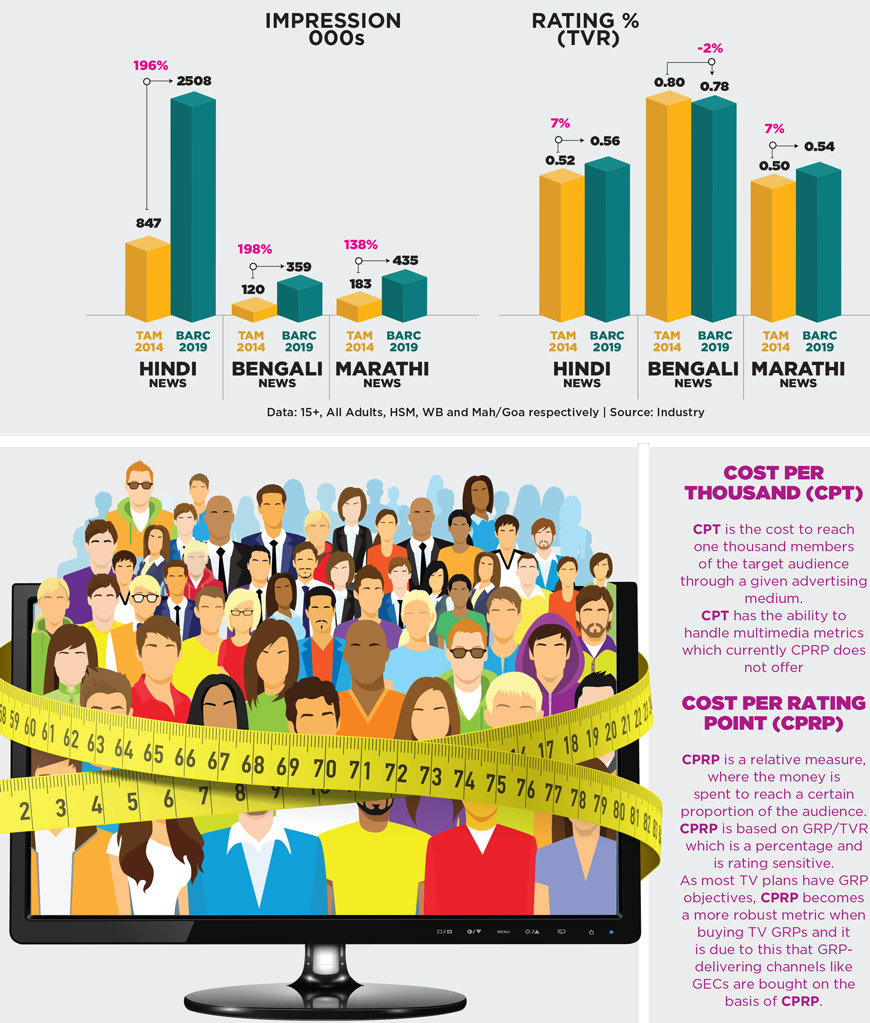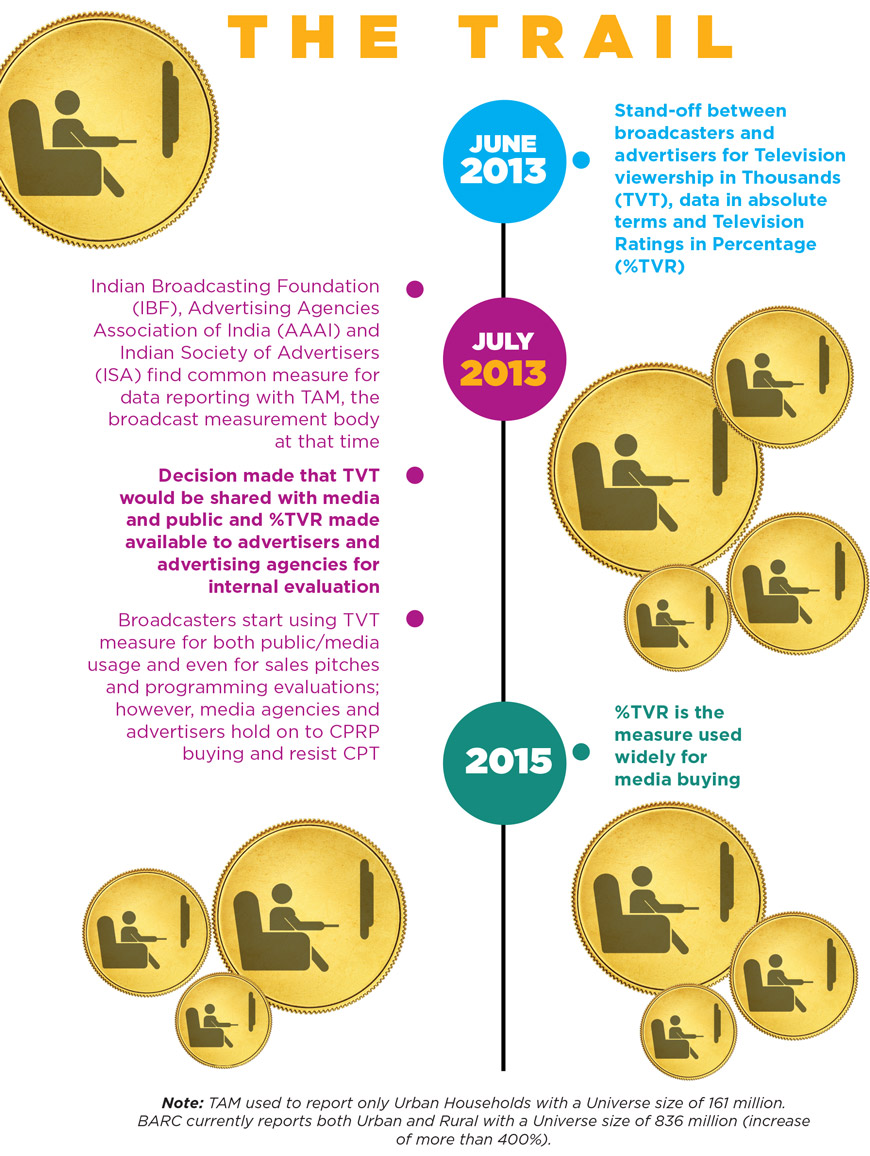However, can the industry still find common ground? In fact, does it really matter whether all stake-holders of the industry, especially in the broadcast domain, reach a common currency measure? Given the day and age of digital viewing and the new tariff regime, does this debate even hold ground, or has it become redundant? Are marketers even waiting for any debate to conclude?
***
The reason CPT was to evolve was to look at all mediums at par - it is defined as the cost of a media vehicle reaching 1,000 members of an audience - and would thus enable cross-media comparison. But with a 900+ TV channel market and 4-5 large digital publishers in place, plus the whole Print ecosystem which continues to grow, a shift to CPT is a long way off and cannot happen overnight.
“I am an advocate of CPT because it allows easier cross-media comparison. Anyone can convert a CPT to a CPRP in a couple of minutes. Marketers who wish to do comparisons are already doing it with CPT or CPRP. Broadcasters expect that trading on CPT rather than CPRP as a currency will help them offset inflation against an increased TV base. But that effect is tiny in the overall scheme of things. The larger plays will involve monies moving across States within TV and across mediums if everything is on CPT. Already, there are marketers who are ensuring that the water across their entire spend is finding its own level. They are not waiting for any debate to conclude,” says Vikram Sakhuja, Group CEO, Madison Media & OOH.
MASSIVE FRAGMENTATION
Despite the fact that Television viewing has grown significantly, fragmentation is also increasing and ratings for shows are dropping. TAM Media Research, the erstwhile broadcast audience measurement body, used to report only Urban Households with a Universe size of 161 million. In comparison, the Broadcast Audience Research Council (BARC) which currently measures TV audiences, reports both Urban and Rural with a Universe size of 836 million (increase of more than 400%). For example, the top GEC show in 2002-03, Kyunki Saas Bhi Kabhi Bahu Thi, used to garner 15 rating points; today, a top show on a GEC gets 4 rating points. Resultantly, the benefit of CPT is negated by this fragmentation leading to reduction in CPRP.
“I do not see a resolution happening because the objectives for broadcasters and advertisers are different. Fragmentation is on the rise as consumers now have more choice and this would generally lead to a fall in rating and if payments are linked to CPRP, then a corresponding fall in revenue for the broadcaster. As the underlying universe of TV viewers continues to increase, even if there is a marginal decrease in ratings, the number of viewers might have increased which would entail advertisers paying a higher sum if they were to transact on CPT basis. This healthy tussle will continue and we believe the solution lies somewhere in going for the middle ground,” explains Rohit Dokania, Senior Vice President, Research, IDFC.

However, broadcasters feel CPT will capture sector growth in the true sense. “It is high time that we seriously evaluate CPT which will capture growth in the true sense and thereby an appropriate cost, rather than depending on CPRP wherein the relevance of the currency is dependent on a ratio which will negate the growth. In a CPT scenario, the game will move from mindlessly ensuring lowest price in the market to the best value,” says Ashish Sehgal, Chief Growth Officer, Advertisement Revenue, Zee Entertainment Enterprises Limited (ZEEL).
IMPACT OF NTO
The impact of the Telecom Regulatory Authority of India (TRAI)’s new tariff order (NTO) is settling down gradually; however, niche channels are yet to find a stable ground. According to KPMG’s ‘India’s Digital Future- Mass of Niches’ report, while the top GECs and movie channels continued to attract marketers, the niche genres like Infotainment, Lifestyle, Youth, Music, etc., suffered the most on account of the uncertainty around their reach and viewership in the new regime. “CPT in today’s situation is probably a better evaluation measure, especially after NTO, which has adversely affected many genres/channels,” says Anita Nayyar, CEO - India & South East Asia, Havas Media Group. “As an industry, we need to graduate collectively and it is hence important for all the three stake-holders -advertisers, media agencies and broadcasters - to be on the same page. CPT for Print and Digital is simpler as compared to Television, given the frequency of availability of data,” she adds.

“Even NTO demands carriage fee from channels on penetration, not rating points. Then what stops us from arriving at a common currency for an evaluation that is acceptable by broadcasters, advertisers and media planners? In this scenario, long tail channels (lesser known channels) will not be able to survive for long due to carriage fee and consumer choice,” says Avinash Pandey, CEO, ABP News Network.
CROSS-MEDIA MEASUREMENT
The Digital medium is generally sold on a CPT basis. So, it’s an actual impression versus a CPRP, which is a relative impression. So, from that perspective, it makes comparison easier. But, advertisers are very clear that they are buying TV on the lowest rate in terms of CPRP. And they themselves can calculate what the CPT is, as they calculate it for Digital. “Teams that are managing Digital and those managing TV are usually different in agencies. They may be reporting to the same person. But, they have having their own KPIs to meet with the same clients. They may convert the measure while unifying their presentation with the client using CPT for comparison across mediums, but may not make this admission to the broadcaster during deal negotiation. Terms are anyway not comparable across media. In Digital (CPM) and Print (CPT), it refers to reach while in TV (TVT), it is a combination of reach and time-spent,” says Vineet Sodhani, CEO, Spatial Access.
“Today, we are measuring last mile impact of the media for the client and from that front, the CPRP and CPT discussions have become redundant, because then you are talking about cost per acquisition and cost per lead. So, thanks to the way the medium has evolved today, I think we have moved ahead on that,” says Priti Murthy, CEO, OMD India.
A shift from CPRP to CPT will require a dramatic change in the industry. Also with the current slowdown in the country, broadcasters should be happy that ads are still flowing in, regardless of CPT or CPRP.
‘Anyone can convert a CPT to a CPRP in a couple of minutes’
 “I am an advocate of CPT because it allows easier cross-media comparison. Anyone can convert a CPT to a CPRP in a couple of minutes. Marketers who wish to do comparisons are already doing it with CPT or CPRP. Broadcasters expect that trading on CPT rather than CPRP as a currency will help them offset inflation against an increased TV base. But that effect is tiny in the overall scheme of things. The larger plays will involve monies moving across States within TV and across mediums if everything is on CPT.”
“I am an advocate of CPT because it allows easier cross-media comparison. Anyone can convert a CPT to a CPRP in a couple of minutes. Marketers who wish to do comparisons are already doing it with CPT or CPRP. Broadcasters expect that trading on CPT rather than CPRP as a currency will help them offset inflation against an increased TV base. But that effect is tiny in the overall scheme of things. The larger plays will involve monies moving across States within TV and across mediums if everything is on CPT.”Vikram Sakhuja
Group CEO, Madison Media & OOH
‘The CPRP and CPT discussions have become redundant today’
 “Today, with data aggregation happening with first, second and third party data across mediums, I don’t see a resolution as a way forward in a very conclusive manner. Today, we are measuring last mile impact of the media for the client and from that front, the CPRP and CPT discussions become redundant, because then you are talking about cost per acquisition and cost per lead. So, thanks to the way the medium has evolved today, I think we have moved ahead on that.”
“Today, with data aggregation happening with first, second and third party data across mediums, I don’t see a resolution as a way forward in a very conclusive manner. Today, we are measuring last mile impact of the media for the client and from that front, the CPRP and CPT discussions become redundant, because then you are talking about cost per acquisition and cost per lead. So, thanks to the way the medium has evolved today, I think we have moved ahead on that.”Priti Murthy
CEO, OMD India
‘First, we should give up the comfort of CPRP usage’
 “Advertisers, agencies and broadcasters should come together to put forth a common blueprint on implication and calibration of transition from CPRP to CPT. But first, we should give up the comfort and familiarity of CPRP usage and its benchmark. We need to be dynamic and agile to adapt as the industry is. We should start preparing this blueprint instead of debating; first kick-off is very important and we should volunteer to take the lead.”
“Advertisers, agencies and broadcasters should come together to put forth a common blueprint on implication and calibration of transition from CPRP to CPT. But first, we should give up the comfort and familiarity of CPRP usage and its benchmark. We need to be dynamic and agile to adapt as the industry is. We should start preparing this blueprint instead of debating; first kick-off is very important and we should volunteer to take the lead.”Himanka Das
CEO, Vizeum India
HOW THE CPT vs CPRP SCENARIO LOOKS
Taking the language news genre in West Bengal and Maharashtra/Goa markets as an example, the comparative data given here shows how in absolute terms the various genres have grown significantly while in terms of percentage, it shows marginal increase or even decrease.
POINTS TO NOTE
Broadcasters expect that trading on CPT rather than CPRP as a currency will help them offset inflation against an increased TV base. But that effect is tiny in the overall scheme of things.
Agencies may convert the measure while unifying their presentation with a client using CPT for comparison across mediums, but may not make the admission to the broadcaster during deal negotiation.
Today, when marketers are talking about last mile impact of media and cost per acquisition and cost per lead, CPRP and CPT discussions become redundant.
‘CPT for Print and Digital is simpler, compared to that for Television’
 “While broadcasters have been trying their level best to go the CPT route and rightfully so, its acceptance is low for fear of incremental cost. CPT will open up the path to pay on the basis of absolute number of people who watch a channel. This will increase the cost for some genres and may also reduce the cost for others. As an industry, we need to graduate collectively and it is hence important for all the three stake-holders viz., advertisers, media agencies and broadcasters, to be on the same page. CPT for Print and Digital is simpler as compared to Television, given the frequency of availability of data.”
“While broadcasters have been trying their level best to go the CPT route and rightfully so, its acceptance is low for fear of incremental cost. CPT will open up the path to pay on the basis of absolute number of people who watch a channel. This will increase the cost for some genres and may also reduce the cost for others. As an industry, we need to graduate collectively and it is hence important for all the three stake-holders viz., advertisers, media agencies and broadcasters, to be on the same page. CPT for Print and Digital is simpler as compared to Television, given the frequency of availability of data.”Anita Nayyar
CEO - India & South East Asia, Havas Media Group
‘Terms are, anyway, not comparable across media’
 “Teams that are managing digital and those managing TV are usually different in agencies. They may be reporting to the same person. But, they have their own KPIs to meet with the same clients. They may convert the measure while unifying their presentation with the client using CPT for comparison across mediums, but may not make the admission to the broadcaster during deal negotiation. Terms are anyway not comparable across media. In Digital (CPM) and Print (CPT), it refers to reach while in TV (TVT) it is a combination of reach and time-spent.”
“Teams that are managing digital and those managing TV are usually different in agencies. They may be reporting to the same person. But, they have their own KPIs to meet with the same clients. They may convert the measure while unifying their presentation with the client using CPT for comparison across mediums, but may not make the admission to the broadcaster during deal negotiation. Terms are anyway not comparable across media. In Digital (CPM) and Print (CPT), it refers to reach while in TV (TVT) it is a combination of reach and time-spent.”Vineet Sodhani
CEO, Spatial Access
‘The solution lies somewhere in going for the middle ground’
 “I don’t see a resolution because the objectives for broadcasters and advertisers are different. Fragmentation is on the rise as consumers now have more choice and this would generally lead to a fall in rating and if payments are linked to CPRP, then a corresponding fall in revenue for the broadcaster. As the underlying universe of TV viewers continues to increase, even if there is a marginal decrease in ratings, the number of viewers might have increased which would entail advertisers paying a higher sum if they were to transact on CPT basis. This healthy tussle will continue and we believe the solution lies somewhere in going for the middle ground.”
“I don’t see a resolution because the objectives for broadcasters and advertisers are different. Fragmentation is on the rise as consumers now have more choice and this would generally lead to a fall in rating and if payments are linked to CPRP, then a corresponding fall in revenue for the broadcaster. As the underlying universe of TV viewers continues to increase, even if there is a marginal decrease in ratings, the number of viewers might have increased which would entail advertisers paying a higher sum if they were to transact on CPT basis. This healthy tussle will continue and we believe the solution lies somewhere in going for the middle ground.”Rohit Dokania
Senior Vice President, Research, IDFC
It is for the industry to jointly come to a consensus: BARC
“The conversation on the trading metric has been going on for quite some time, and it is for the industry to jointly come to a consensus. As the measurement company, we provide the data in both absolute impressions and percentage.”
A Broadcast Audience Research Council (BARC) India spokesperson
‘CPT has not been adopted so far perhaps due to inertia and fear of change’
 “CPT is obviously a simpler metric which is easy to understand and interpret for all stake-holders and is already in use in the Print industry. It is even more important to have a common currency in a multi-media world where a marketer has to make choices and comparisons across different media platforms. In fact, it would also be useful for doing comparisons across markets/countries. CPT has not been adopted so far perhaps due to inertia and fear towards a change which would be required by all stake-holders and across all platforms.”
“CPT is obviously a simpler metric which is easy to understand and interpret for all stake-holders and is already in use in the Print industry. It is even more important to have a common currency in a multi-media world where a marketer has to make choices and comparisons across different media platforms. In fact, it would also be useful for doing comparisons across markets/countries. CPT has not been adopted so far perhaps due to inertia and fear towards a change which would be required by all stake-holders and across all platforms.”Vivek Nayer
CMO, Group Corporate Brand, Mahindra & Mahindra Ltd.
‘This is quite the debate of Pound & Lira versus the Euro’
“
 This debate will continue, and the broadcaster, the media planner and advertiser will remain divided in opinion. The broadcaster will benefit from the CPT norm. Sellers want to sell at CPT and buyers want to continue to buy at CPRP. The idea around is, why rock the boat? There are still doubts on quality. The broadcaster is really salivating at CPT, as he/she/they know that India’s CPT is lowest in the world even today. This cannot continue. The debate is all about currency, in which stake-holders normally feel comfortable with what they know, and what they have established and dealt with for decades. This is quite the debate of Pound and Lira versus the relatively new Euro.”
This debate will continue, and the broadcaster, the media planner and advertiser will remain divided in opinion. The broadcaster will benefit from the CPT norm. Sellers want to sell at CPT and buyers want to continue to buy at CPRP. The idea around is, why rock the boat? There are still doubts on quality. The broadcaster is really salivating at CPT, as he/she/they know that India’s CPT is lowest in the world even today. This cannot continue. The debate is all about currency, in which stake-holders normally feel comfortable with what they know, and what they have established and dealt with for decades. This is quite the debate of Pound and Lira versus the relatively new Euro.”Harish Bijoor
Brand Guru & Founder, Harish Bijoor Consults Inc.
‘What stops us from arriving at a common currency for evaluation?’
 “Even NTO demands carriage fee from channels on penetration, not rating points. Then what stops us from arriving at a common currency for evaluation that is acceptable by broadcasters, advertisers and media planners? In this scenario, long tail channels (less known channels) will not be able to survive for long due to carriage fee and consumer choice.”
“Even NTO demands carriage fee from channels on penetration, not rating points. Then what stops us from arriving at a common currency for evaluation that is acceptable by broadcasters, advertisers and media planners? In this scenario, long tail channels (less known channels) will not be able to survive for long due to carriage fee and consumer choice.”Avinash Pandey
CEO, ABP News Network
‘We need a common metric and CPT is a very powerful one’
 “Until now, on digital display, advertising was the mainstay but now with video advertising gaining prominence, marketers are looking at campaign efficiency and efficacy across platforms. Hence, there is a need for a common metric and CPT is a very powerful one. Also, in an environment where plans are getting more and more integrated, cross-media comparison becomes important. CPT is the single currency that will allow apple-to-apple comparability across and within media.”
“Until now, on digital display, advertising was the mainstay but now with video advertising gaining prominence, marketers are looking at campaign efficiency and efficacy across platforms. Hence, there is a need for a common metric and CPT is a very powerful one. Also, in an environment where plans are getting more and more integrated, cross-media comparison becomes important. CPT is the single currency that will allow apple-to-apple comparability across and within media.”Ashish Sehgal
Chief Growth Officer, Ad Revenue, ZEEL
‘Moving from CPRP to CPT buying will bring about rationalization’
 “Moving from CPRP buying to CPT buying with rates that are commensurate with audience deliveries will bring about the required rationalization that is missing in the current ecosystem. Currently, all other media platforms including digital are being bought on the basis of audience deliveries. Television is the only exception to this practice and this shift will also impose the essential uniformity across platforms which will eventually benefit all the parties including the advertisers.”
“Moving from CPRP buying to CPT buying with rates that are commensurate with audience deliveries will bring about the required rationalization that is missing in the current ecosystem. Currently, all other media platforms including digital are being bought on the basis of audience deliveries. Television is the only exception to this practice and this shift will also impose the essential uniformity across platforms which will eventually benefit all the parties including the advertisers.”Pawan Jailkhani
Chief Revenue Officer, 9X Media Pvt. Ltd
























